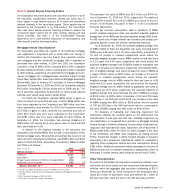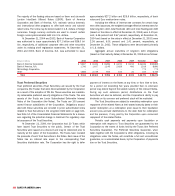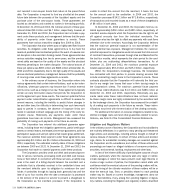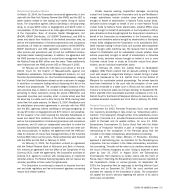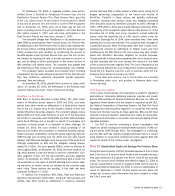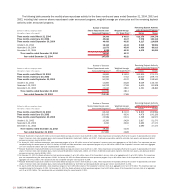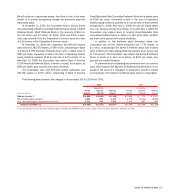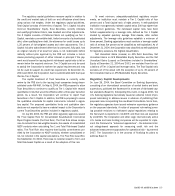Bank of America 2004 Annual Report Download - page 127
Download and view the complete annual report
Please find page 127 of the 2004 Bank of America annual report below. You can navigate through the pages in the report by either clicking on the pages listed below, or by using the keyword search tool below to find specific information within the annual report.
and invested in zero-coupon bonds that mature at the preset future
date. The Corporation is required to fund any shortfall at the preset
future date between the proceeds of the liquidated assets and the
purchase price of the zero-coupon bonds. These guarantees are
booked as derivatives and marked to market in the trading portfolio.
At December 31, 2004 and 2003, the notional amount of these guar-
antees totaled $8.1 billion and $6.7 billion, respectively; however, at
December 31, 2004 and 2003, the Corporation had not made a pay-
ment under these products, and management believes that the prob-
ability of payments under these guarantees is remote. These
guarantees have various maturities ranging from 2006 to 2016.
The Corporation has also written puts on highly rated fixed income
securities. Its obligation under these agreements is to buy back the
assets at predetermined contractual yields in the event of a severe mar-
ket disruption in the short-term funding market. These agreements have
various maturities ranging from two to seven years, and the pre-deter-
mined yields are based on the quality of the assets and the structural
elements pertaining to the market disruption. The notional amount of
these put options was $653 million and $666 million at December 31,
2004 and 2003, respectively. Due to the high quality of the assets and
various structural protections, management believes that the probability
of incurring a loss under these agreements is remote.
In the ordinary course of business, the Corporation enters into
various agreements that contain indemnifications, such as tax indem-
nifications, whereupon payment may become due if certain external
events occur, such as a change in tax law. These agreements typically
contain an early termination clause that permits the Corporation to
exit the agreement upon these events. The maximum potential future
payment under indemnification agreements is difficult to assess for
several reasons, including the inability to predict future changes in
tax and other laws, the difficulty in determining how such laws would
apply to parties in contracts, the absence of exposure limits con-
tained in standard contract language and the timing of the early ter-
mination clause. Historically, any payments made under these
guarantees have been de minimis. Management has assessed the
probability of making such payments in the future as remote.
The Corporation has entered into additional guarantee agree-
ments, including lease end obligation agreements, partial credit guar-
antees on certain leases, real estate joint venture guarantees, sold risk
participation swaps and sold put options that require gross settlement.
The maximum potential future payment under these agreements was
approximately $2.1 billion and $1.3 billion at December 31, 2004 and
2003, respectively. The estimated maturity dates of these obligations
are between 2005 and 2033. At December 31, 2004 and 2003, the
Corporation had made no material payments under these products.
The Corporation provides credit and debit card processing serv-
ices to various merchants, processing credit and debit card transac-
tions on their behalf. In connection with these services, a liability may
arise in the event of a billing dispute between the merchant and a
cardholder that is ultimately resolved in the cardholder’s favor and
the merchant defaults upon its obligation to reimburse the card-
holder. A cardholder, through its issuing bank, generally has until the
later of up to four months after the date a transaction is processed
or the delivery of the product or service to present a chargeback to
the Corporation as the merchant processor. If the Corporation is
unable to collect this amount from the merchant, it bears the loss
for the amount paid to the cardholder. In 2004 and 2003, the
Corporation processed $143.1 billion and $71.8 billion, respectively,
of transactions and recorded losses as a result of these chargebacks
of $6 million in both years.
At December 31, 2004 and 2003, the Corporation held as col-
lateral approximately $203 million and $182 million, respectively, of
merchant escrow deposits which the Corporation has the right to set
off against amounts due from the individual merchants. The
Corporation also has the right to offset any payments with cash flows
otherwise due to the merchant. Accordingly, the Corporation believes
that the maximum potential exposure is not representative of the
actual potential loss exposure. Management believes the maximum
potential exposure for chargebacks would not exceed the total amount
of merchant transactions processed through Visa and MasterCard for
the last four months, which represents the claim period for the card-
holder, plus any outstanding delayed-delivery transactions. As of
December 31, 2004 and 2003, the maximum potential exposure
totaled approximately $93.4 billion and $25.0 billion, respectively.
Within the Corporation’s brokerage business, the Corporation
has contracted with third parties to provide clearing services that
include underwriting margin loans to the Corporation’s clients. These
contracts stipulate that the Corporation will indemnify the third par-
ties for any margin loan losses that occur in their issuing margin to
the Corporation’s clients. The maximum potential future payment
under these indemnifications was $1.2 billion and $486 million at
December 31, 2004 and 2003, respectively. Historically, any pay-
ments made under these indemnifications have not been material.
As these margin loans are highly collateralized by the securities held
by the brokerage clients, the Corporation has assessed the probabil-
ity of making such payments in the future as remote. These indem-
nifications would end with the termination of the clearing contracts.
For additional information on recourse obligations related to res-
idential mortgage loans sold and other guarantees related to securi-
tizations, see Note 8 of the Consolidated Financial Statements.
Litigation and Regulatory Matters
In the ordinary course of business, the Corporation and its subsidiaries
are routinely defendants in or parties to many pending and threatened
legal actions and proceedings, including actions brought on behalf of
various classes of claimants. In certain of these actions and proceed-
ings, claims for substantial monetary damages are asserted against
the Corporation and its subsidiaries, and certain of these actions and
proceedings are based on alleged violations of consumer protection,
securities, environmental, banking, employment and other laws.
In view of the inherent difficulty of predicting the outcome of such
matters, particularly where the claimants seek very large or indeter-
minate damages or where the cases present novel legal theories or
involve a large number of parties, the Corporation cannot state with
confidence what the eventual outcome of the pending matters will be,
what the timing of the ultimate resolution of these matters will be or
what the eventual loss, fines or penalties related to each pending
matter may be. Based on current knowledge, management does not
believe that liabilities, if any, arising from pending litigation or regula-
tory matters, including the litigation and regulatory matters described
126 BANK OF AMERICA 2004



